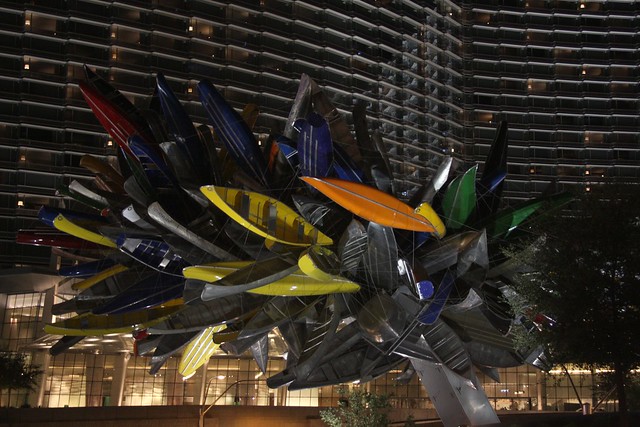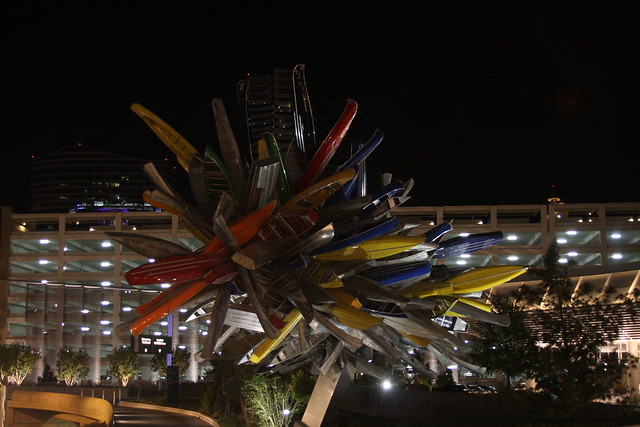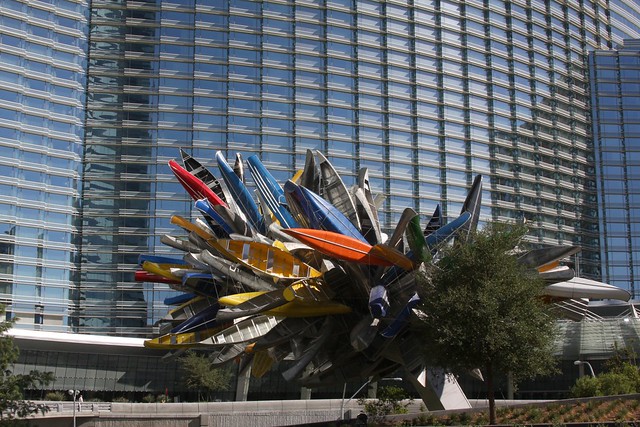View Larger Map
A few photos of Collins Circle, the weird traffic circle at 18th & Jefferson in downtown Portland, next to the Goose Hollow MAX stop. We are not, generally speaking, a city of grand traffic circles. There's
Coe Circle in Laurelhurst, with the famous Joan of Arc statue. There's Ladd Circle in the heart of Ladd's Addition, with a nice little garden full of roses, if you go in season and can find your way around Ladd's Addition. (But hey, wandering around lost there is half the fun.) Here and there around town you'll find a number of
mini-circles, which exist to slow traffic down in residential neighborhoods. And then there's Collins Circle, which contains the large and rather puzzling stone sculpture you see here.

People generally don't even notice the thing, which may be just as well. I'm not a big fan of it myself, although you can get some (mildly) interesting photos out of it, and it might be fun spending a few minutes speculating about what it's supposed to be, or what it's supposed to evoke. It looks sort of like an old, forgotten stone wall, sort of like an arid talus slope, and I'm not sure what the shape of it is supposed to indicate. (You can get a better idea of the shape from
this overhead view) Is it supposed to shaped like a pizza missing a slice, due to the nearby student housing for PSU? Is it Pac-Man? To me, it gives the strong sense that something's missing here. There really ought to be a fountain, with water running over the rocks, or at least a reflecting pool around it. Or it's a sundial without the bits that tell time. Or it's the base of a missing statue. Or there's a door on one side, leading to the fabulous underground tomb of a cruel pagan king of yore. It could be lots of things, but sadly isn't any of them.

If you want to see more (and better) photos of the thing, Art on File has a few
here. The University of Oregon has a fairly large
collection of photos, but they are apparently Classified and not to be seen by mere mortals. So if you happen not to be a mere mortal, you might check those photos out as well.
The Oregonian's Randy Gragg was a friend of the circle's architect/designer, the late
Robert Murase. When Murase died in 2005, Gragg wrote
an article about his life and career, and mentioned Collins Circle in passing:
Like most architects, who deal with clients and budgets out of their control, Murase's projects weren't always successful. Maybe most tragic was the truly excellent work he did in setting the stage for architecture that ultimately failed to rise to the challenge his landscapes made. Chief among these works is one of the most assertive works Murase ever did: the stout, basalt Japanese infinity design he created for TriMet to fill Collins Circle at the Southwest 18th and Jefferson Westside MAX station.
The piece only "met its context halfway," according to Greg Baldwin, a prominent local architect with ZGF Partnership. The subsequent designs around it have failed to hold up their side of the bargain in the form, materials and ideas.
"I look at his work in a lot of places, and I wish the architects had done more -- that I had done more," Baldwin said. "There's an intellectual contribution he made with his work that is more profound than its aesthetic contribution. There are deep polemics, but he never imposed them. It's up to the observer to discover them."
It's nice to speak well of the dead, of course, and it's nice to speak well of one's friends, certainly. But that passage is just rich. It really is. Admit the thing is unsuccessful, but lay all the blame on subsequent nearby buildings that didn't measure up to the "challenge". At the time the article was written, the only subsequent nearby building was the adjacent
Collins Circle Apartments, so I figure this is what they have in mind. And it's true, the building is a fairly generic, inoffensive affair, a six story red brick apartment building with retail on the bottom. It's not the work of internationally renowned architects, but perhaps because of that, it's also affordable enough that university students can live there. That's not a point to be dismissed out of hand.

Gragg once
referred to the circle as
"one of the boldest pieces of public art since [Lawrence Halprin's] Lovejoy Fountain.". Which, again, is rich. Longtime readers know I'm a big fan of
Lovejoy Fountain, and photos of it show up here all the time. Collins Circle, you're no Lovejoy Fountain.
A
1998 piece about the then-new westside MAX line's public art describes the circle:
Collins Circle, across the street from Goose Hollow Station, was designed as "a gateway to the city." Murase sees the stone-studded traffic circle as a representation of ancient, evolving Oregon landscapes, the boxy stones reminiscent of burial mounds and symbolic of volcanic activity that shaped Eastern Oregon.
"It's a thoughtful place," he said. "It will cause a lot of questions. I like to have people think about it."
In a
1997 overview of the year's "interesting" architecture of the year, the Graggmeister wrote:
The gateway as art
Thought we were just talking about architecture here? Well, an architect wins this category, hands down: Robert Murase for his bracing design of Collins Circle at the crossroads of Southwest 18th Avenue and Jefferson Street and the westside light-rail line. Rendering a spiraling Japanese brush-painting symbol called enso in fractured chunks of basalt, the circle has enough spirituality to lure New Age worshipers on summer mornings. But it has the scale to function as a gateway to the city -- the one of the future rather than the present.
Call me deficient in New Age spirituality if you like (and you'd be right), but a mound of mute stones just doesn't stir my soul much. I look at it, and what I see is a missed opportunity. Somewhere near here, during westside MAX construction, workers
uncovered a huge pulley that was once part of Portland's short-lived cable car line. Cable cars once ran from this very spot up into the West Hills, on a long and very steep trestle. The pulley operated a turntable to rotate cars for their next trip up the hill. I wonder if the circle was the site of the turntable, way back when? The story doesn't say exactly, but it seems like a reasonable guess. So some sort of historical, transit-related theme would've been a good fit here.
If you just can't get enough of Gragg's design-junkie blather, he also wrote a whole feature article about the circle back in '97,
"The Power of the Graceful Contrast". Towards the bottom, he discloses a controversy about the place:
No less controversial for some was Murase's design for Collins Circle, which had been planted with trees and rhododendrons paid for by local benefactor Mary Beth Collins. Like many recent changes in the city, it was not greeted warmly by many longtime locals.
``The old circle was a nice landscape that Tri Met just scraped away without any public talking to anyone in the neighborhood,'' Portland planner Richard Brainard says. ``You used to come down Canyon Road and the circle marked the beginning of downtown with something green. Now it's just rocks. Bob is a great landscape architect, but the way this was done and the result is just not right.''
Read enough of this and you'll conclude what I concluded a long time ago, that architecture is nothing but the art of creative BS. Master that, and people will let you build
anything. You want to sculpt a centaur that looks like Elvis, made out of pure, glowing plutonium? Just memorize a few stock art-world phrases, schmooze with the right movers and shakers, and you'll be good to go. You'll have to design an addition to your house just to hold all the awards your fellow architects will bestow on you. If possible, you'll want to work in a self-conscious small city like Portland, where everyone's been taught that only ignorant Bible-thumping rubes criticize capital-A Art. But I digress.

People who noticed the circle were calling BS on it from the beginning, as you can tell from a 1995 article titled
"That Sloping Basalt Feature Will Come Full Circle . . . Eventually". The piece pleaded for patience, at least until MAX construction was completed:
Some people who have glimpsed the sloping basalt feature in the intersection are puzzled: What is it? What is a fortress doing in the middle of the street?
Patience, friends.
When the roadwork is done and the design completed, the image may be more evocative.
The article says the previous landscaping at the circle had been paid for by the
Collins Foundation, a local nonprofit, hence the name.
The article also mentions that the sculpture is Not For Climbing. Pedestrians are not wanted here. Or more to the point, I've seen homeless people sleeping among the landscaping in both Ladd Circle and Coe Circle, but not here. Skateboarders are out of luck here, too, come to think of it. You never even see kids playing on it, using it as a play fort or anything. It's entirely uninviting for all of these purposes. I don't know if that was intentional or not, but either way it does a heckuva job.
In fairness, traffic circles are a tough nut, designwise. They tend to be surrounded by a snarl of traffic, so you can't really create them for pedestrians. The Joan of Arc in Coe Circle works - you can see it at a distance, and tell what it is with a glance as you drive by. Likewise with the roses in Ladd Circle. Ladd Circle isn't quite so busy, so you could also walk over to it and look at the roses if you wanted to.
At Collins Circle, half of the circle is busy and half isn't. It wasn't designed for people, but people cut across it all the time anyway, since it's the shortest path between the MAX stop and the sidewalk on SW Jefferson St. You're not really supposed to, but it seems everyone does, and I did when I was taking the photos. It doesn't really catch the eye when you drive past, or ride by on the train. I used to ride right past the thing on the train every day for years and never gave it a second thought. I really never thought about until a week or two ago, while I was searching for anything convenient to add to my ongoing city parks series. It kind of pushes the definition a little, but at least it's conveniently located.
Art people look at the thing and wonder, is it a park, or a sculpture? There's just no end to the art-theory fun you could get out of that question, if you're that sort of person. I wonder the same thing, actually, but for a more mundane, PoliSci-geek reason: Who's in charge of the thing? If some punk kid tags it, which bureaucracy's budget pays to fix it? Some maps, like the city's
SW Walking Map, list it as a "Jefferson Street Park", but there's no sign and it's not on the parks bureau's website. The
Regional Arts & Culture Council normally takes care of public art, but it's not on their website either. Likewise, TriMet and the city's transportation department also don't claim it.
I tend to focus on parks, historic places and things, local urban legends, social conventions and mores, and such because I'm interested in the shared fabric of the city, the things that make Portland what it is. Why we're not just like L.A. or Atlanta, for instance. I'm not that interested in the official, approved history of the place, and I also shy away from boosterism, whether of the Visitors' Center or "Keep Portland Weird" varieties. I'll make up my own mind, thanks. I occasionally get visitors who freak out when I call BS on some local institution or make snide remarks about the Pearl District or something. But really, how can people say they care about the place but refuse to acknowledge the warts when they crop up? You ignore the warts, you get more warts, and the city you care about loses a little more of what makes it special.
When I see a bungled opportunity like this, it offends me because we really don't have that much common space here, places you can sit and read a book without having to buy a crappy $5 latte, or go for a walk without paying admission. On the very rare occasion that we're creating a park close to the downtown core, the effort ought to be taken a little more seriously than this one was. You don't just pick a well-connected architect and let them have a wank at taxpayer expense, which is basically what the circle is, if you ask me. Somehow we keep ending up with one perplexing conceptual piece after another, while pretending it's all so very sophisticated. As if mystifying the general public was somehow
difficult or something. To make it worse, one of the core tenets of the design/architecture world is that once something like this is in place, you can never, ever change anything about it. It's literally set in stone, forever. If you think it'd look better with a reflecting pool at the base, too bad. It wasn't part of the holy original vision, so you're out of luck. Forever. In practice, things do get changed around sometimes, but it's often a long and arduous process. So what you
really want to do is get it right the first time. This time we didn't, and now we're stuck with it. Blechhhh.





